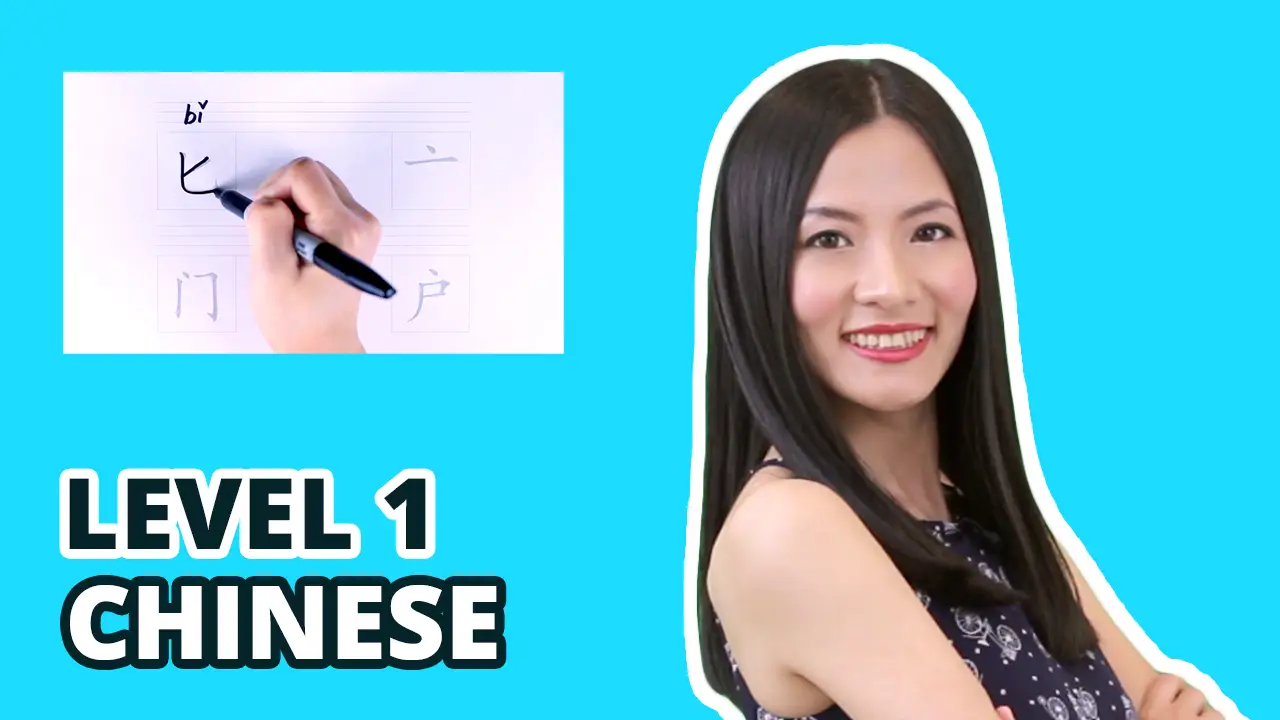Level 1 Lesson 29.1 – I Miss You A Lot Everyday Too
Too, Also in Chinese 也 | Every in Chinese 每 | Both, All in Chinese 都
In this video lesson we'll learn three useful adverbs in Chinese: Every in Chinese 每; too, also in Chinese 也 and both, all in Chinese 都. We'll also learn about the 每……都…… Structure.
- Too, Also in Chinese 也
- Every in Chinese 每
- Both, All in Chinese 都 - Adverb 都 (I). See also Adverb 都 (II) in Level 2 Lesson 24.
- The 每……都 Structure
VOCABULARY
GRAMMAR
Grammar 1: Too, Also in Chinese 也 · HSK 1
To say too, also in Chinese we use the Adverb 也 yě. It is usually used as an Adverbial modifying the Predicate, and is put before the Predicate in a sentence, following this structure:
Subject + 也 + Predicate (+Object)
For example,
(1) with Verb Predicate
- tā zuò dìtiě qùshàngbān, wǒ yě zuò dìtiě qù shàngbān
他坐地铁去上班,我也坐地铁去上班。
he takes subway to go to work, I also take subway to go to work - zhèlǐ xiàyǔ, yě xiàxuě
这里下雨,也下雪。
here rains, also snows
(2) with Adjective Predicate
- wǒ zuótiān bù shūfu, tā jīntiān yě bù shūfu
我昨天不舒服,他今天也不舒服。
I yesterday (was) not feeling well, he today also not feeling well - zuò dìtiě hěn piányi, yě hěnkuài
坐地铁很便宜,也很快。
taking subway (is) very inexpensive, also very fast
Grammar 2: Every in Chinese 每 · HSK 1
To say every in Chinese we use the Pronoun 每 měi, which means every. Usually we say 每 plus the Measure Word, plus the thing, following this structure:
每 + Measure Word + Noun (Phrase)
For example,
- měi wèi bìngrén
每位病人
every "wei" (of) patient - měi liàng chūzūchē
每辆出租车
every "liang" (of) taxi
Some Time Words are especial and they can be used directly after 每, without any Measure Word, following this structure:
每 + Time Word
For example,
- měi tiān 每天 every day
- měi zhōu 每周 every week
- měi nián 每年 every year
- měi fēnzhōng 每分钟 every minute
Some other Time Words are okay both with or without the Measure Word, phrases with the measure word 个 is more of spoken language though:
每 + 个 + Time Word
For example,
(1) with Measure Word 个
- měi ge xiǎoshí 每个小时 every hour
- měi ge xīngqī 每个星期 every week
- měi ge yuè 每个月 every month
(2) without Measure Word 个
- měi xiǎoshí 每小时 every hour
- měi xīngqī 每星期 every week
- měi yuè 每月 every month
Grammar 3: Both, All in Chinese 都 · HSK 1
To say both, all in Chinese we can use the Adverb 都.
都 is a Range Adverb 范围副词 Fànwéi fùcí. A 范围副词 modifies the Predicate, and suggests that “what the predicate talks about” includes the whole group that the Subject refers to. So the Subject usually refer to a group of things/items/people. Sentences that have Adverb 都 usually follow this structure:
Subject [Group(a, b, ... , n)] + 都 + Predicate (+Object)
For example,
(1) with Verb Predicate
- xīngqīyī hé xīngqī'èr dōu xiàxuě le
星期一和星期二都下雪了。
Monday and Tuesday both (had) snow(ed) - tāmende míngzi dōushì sāngezì
他们的名字都是三个字。
their names all are three-character
(2) with Adjective Predicate
- tāmende nánpéngyou dōu hěnshuài
她们的男朋友都很帅。
their boyfriends (are) both very handsome - huǒchē hé fēijī dōu búmàn
火车和飞机都不慢。
train(s) and plane(s) (are) both not slow
Grammar 4: The 每……都 Structure · HSK 1
Since 每 měi means every, phrases like "每个人 měigerén everyone", "每天 měi tiān every day" are basically talking about more than one thing/person, which is a "group". So 每 can be used with 都, as "the 每……都 Structure".
The 每……都 Structure is a very useful and common structure in Chinese. Here the "每 phrase" is the Subject, with 每 + a noun. phrase, usually with the noun’s measure word, but sometimes there’s no measure word, and then the Adverbial 都, Predicate. Following this structure:
Subject [每 (+ M.W.) + N. Phrase] + 都 + Predicate (+Object)
For example,
(1) with Verb Predicate
- měizhīmāo dōushì nǐde ma
每只猫都是你的吗?
every "zhi" cat all is yours -ma - měiwèi bìngrén dōu zǒu le
每位病人都走了。
every "wei" patient all (have) left
(2) with Adjective Predicate
- měiliàngchē dōu hěnmàn
每辆车都很慢。
every "liang" che (are) all very slow - měitiān dōu fēicháng rè le
每天都非常热了。
every day (is) all extremely hot (now)
And the 每 Phrase doesn’t necessarily have to be the Subject either. It is also commonly used as the Adverbial of the sentence, to modify the Predicate. Following this Structure:
Subject + Adverbial [每 (+ M.W.) + N. Phrase] + 都 + Predicate (+Object)
For example,
- wǒ měi ge xīngqī dōu qù shūdiàn
我每个星期都去书店。
I every "ge" (of) week all go to (the) bookstore - tā měifēnzhōng dōu xiǎng huíjiā
他每分钟都想回家。
he every minute all wants to go home
3 Comments
Leave a Reply
You must be logged in to post a comment.

A:你每天怎么去学校吗?
B:我每周一和周三都开车去学校。你呢?
A:我不去学校,我用我的电脑学习汉语。和我不知道开车了。
B:我也在家都用电脑。我每周一和周三都我们开车,怎么样?
A:好的,谢谢。我想去中文上课。和我想念老师。
How come there is no 吗 at the end of the question 你的电脑很慢? Was it meant to be a statement instead?
It was a question. The question is “asked” by Intonation, so there is no question word used.